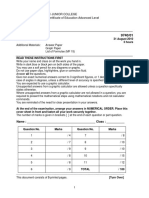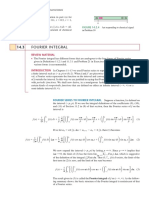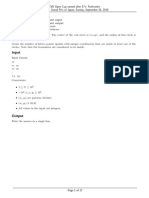Computational Topology Homework 1
Computational Topology Homework 1
Uploaded by
Govind GopakumarCopyright:
Available Formats
Computational Topology Homework 1
Computational Topology Homework 1
Uploaded by
Govind GopakumarOriginal Description:
Copyright
Available Formats
Share this document
Did you find this document useful?
Is this content inappropriate?
Report this DocumentCopyright:
Available Formats
Computational Topology Homework 1
Computational Topology Homework 1
Uploaded by
Govind GopakumarCopyright:
Available Formats
Exercises
15
Exercises
The credit assignment reflects a subjective assessment of difficulty. A typical
question can be answered using knowledge of the material combined with some
thought and analysis.
1. Deciding connectivity (one credit). Given a simple graph with n vertices
and m edges, the disjoint set system takes O((n + m)(n)) time to decide
whether or not the graph is connected.
(i) Give an algorithm that makes the same decision in time O(n + m).
(ii) Modify the algorithm so it computes the connected components in
time O(n + m).
2. Shelling disks (three credits). Consider a triangulation of a simple closed
polygon in the plane, but one that may have vertices in the interior of the
disk. A shelling is a total order of the triangles such that the union of the
triangles in any initial sequence is a closed disk. Prove that every such
triangulation has a shelling.
3. Jordan curve (two credits). Recall the Jordan Curve Theorem which says
that every simple closed curve in the plane decomposes R2 into two.
(i) Show the same is true for a simple closed curve on the sphere, S2 =
{x R2 | kxk = 1}.
(ii) Give an example that shows the result does not hold for simple closed
curves on the torus.
4. Homeomorphisms (two credits). Give explicit homeomorphisms to show
that the following spaces with topologies inherited from the respective
containing Euclidean spaces are homeomorphic:
R1 = R , the real line;
(0, 1), the open interval;
S1 {(0, 1)}, the circle with one point removed.
Generalize your homeomorphisms to show the same for the Euclidean
plane, the open disk, and the sphere with one point removed.
5. Splitting a link (two credits). Prove that the Borromean rings are not
splittable.
6. Deforming a link (two credits). Use Reidemeister moves to demonstrate
that the two links in Figure I.13 are equivalent.
16
Graphs
Figure I.13: Two generic projections of the Whitehead link.
7. Planar graph coloring (two credits). Recall that every planar graph has
a vertex of degree at most five. We can use this fact to show that every
planar graph has a vertex 6-coloring, that is, a coloring of each vertex
with one of six colors such that any two adjacent vertices have different
colors. Indeed, after removing a vertex with fewer than six neighbors we
use induction to 6-color the remaining graph and when we put the vertex
back we choose a color that differs from the colors of its neighbors. Refine
the argument to prove that every planar graph has a vertex 5-coloring.
8. Edge coloring (three credits). Consider a planar graph such that all regions in the embedding in the plane are bounded by exactly three edges,
including the outer region. We color each edge with one of three colors
such that each region has all three different colors in its boundary.
(i) Show that a 4-coloring of the vertices implies a 3-coloring of the edges.
(ii) Show that a 3-coloring of the edges implies a 4-coloring of the vertices.
In other words, proving that every planar graph has a vertex 4-coloring
is equivalent to proving that every triangulation in the plane has an edge
3-coloring.
You might also like
- Matrix PosterDocument2 pagesMatrix Posterapi-433342627100% (1)
- BulgarianMO1960 2008Document104 pagesBulgarianMO1960 2008hungkgNo ratings yet
- Algebraic Geometry Class Notes - GathmannDocument132 pagesAlgebraic Geometry Class Notes - Gathmannx x xNo ratings yet
- Cls Jeead-17-18 Xii Mat Target-6 Set-2 Chapter-5Document84 pagesCls Jeead-17-18 Xii Mat Target-6 Set-2 Chapter-5Sagar MalhotraNo ratings yet
- Tedds Function ReferenceDocument903 pagesTedds Function ReferenceCSEC Uganda Ltd.No ratings yet
- Final Quiz 1Document3 pagesFinal Quiz 1Erick GarciaNo ratings yet
- 95mat2 3Document12 pages95mat2 3aaoneNo ratings yet
- Rus MO402Document4 pagesRus MO402Mauricio ArrascueNo ratings yet
- CJC 2010 Prelim Math p1Document5 pagesCJC 2010 Prelim Math p1Kenrick KiletNo ratings yet
- Laue & Bravis Crystal LatticeDocument18 pagesLaue & Bravis Crystal LatticeRSLNo ratings yet
- APL 100: Minor 2Document3 pagesAPL 100: Minor 2kamleshNo ratings yet
- Chapter 3 Range: 10.6 Surfaces in SpaceDocument17 pagesChapter 3 Range: 10.6 Surfaces in SpaceBalween DhindsaNo ratings yet
- Mathematics: Higher School Certificate ExaminationDocument16 pagesMathematics: Higher School Certificate ExaminationAlan TruongNo ratings yet
- 9709 w13 QP 11Document4 pages9709 w13 QP 11universally123No ratings yet
- Midterm Practice Problems: N N 1 N 2 N 3 N 4Document10 pagesMidterm Practice Problems: N N 1 N 2 N 3 N 4Lionel CarlosNo ratings yet
- Chinease Postman ProblemDocument9 pagesChinease Postman Problemvk100No ratings yet
- Math Gurus Paper 1question PaperDocument14 pagesMath Gurus Paper 1question PaperElijah KirigaNo ratings yet
- Set 09 Soalan PDFDocument12 pagesSet 09 Soalan PDFTing ShiangNo ratings yet
- Mathematics - Paper 2 - Question PaperDocument20 pagesMathematics - Paper 2 - Question Paperfwaithaka35No ratings yet
- Poliedros y GraficasDocument9 pagesPoliedros y GraficasAldo ValverdeNo ratings yet
- 2016 SRP ChladniDocument4 pages2016 SRP ChladniFrane DuiloNo ratings yet
- MATHEMATICS 9740/01: Catholic Junior College General Certificate of Education Advanced Level Higher 2Document5 pagesMATHEMATICS 9740/01: Catholic Junior College General Certificate of Education Advanced Level Higher 2nothingtodo1992No ratings yet
- 23 HW3Document2 pages23 HW3toby121802No ratings yet
- Math Vectors v2Document72 pagesMath Vectors v2Rowanberry11No ratings yet
- DS SecondMidtermDocument17 pagesDS SecondMidtermTetricx The firstNo ratings yet
- Planar Graphs and Modular OrigamiDocument9 pagesPlanar Graphs and Modular OrigamiArmando GumucioNo ratings yet
- Computational Geometry Practice Final - Solution NotesDocument4 pagesComputational Geometry Practice Final - Solution NotesBibodiNo ratings yet
- Combinatorics Grids and ChessboardsDocument7 pagesCombinatorics Grids and Chessboardsarmy forever indiaNo ratings yet
- 2009 HSC Exam MathematicsDocument16 pages2009 HSC Exam MathematicsYoga NathanNo ratings yet
- S4 N5 BT1 Revision SheetDocument11 pagesS4 N5 BT1 Revision SheetMarisa VetterNo ratings yet
- Zhang&Ding HoneycombDocument4 pagesZhang&Ding HoneycombCarlo CellucciNo ratings yet
- On The Mathematics of Flat Origami - HullDocument10 pagesOn The Mathematics of Flat Origami - HullGugaKlingNo ratings yet
- HW 2Document1 pageHW 2Yuhua WangNo ratings yet
- 9709 s13 QP 12Document4 pages9709 s13 QP 12Abrar JahinNo ratings yet
- A04 Coordinate GeometryDocument102 pagesA04 Coordinate GeometryAzizmanvaNo ratings yet
- MATHEMATICSDocument52 pagesMATHEMATICSTata JillsNo ratings yet
- EndsemDocument3 pagesEndsemfirebase appsNo ratings yet
- Algebraic Geometry PDFDocument133 pagesAlgebraic Geometry PDFgsitciaNo ratings yet
- Solid State Theory - EDocument27 pagesSolid State Theory - Ethinkiit100% (3)
- FEM Exam With SolutionDocument8 pagesFEM Exam With SolutionArifian Agusta100% (2)
- Instructions: This Question Paper Consist of Two Sections. Section A and Section B. AnswerallDocument16 pagesInstructions: This Question Paper Consist of Two Sections. Section A and Section B. AnswerallSiti Suriani Mohd YusofNo ratings yet
- SSVM Institutions Periodic Test 2 Mathematics: (Each Question Carries 1 Mark)Document3 pagesSSVM Institutions Periodic Test 2 Mathematics: (Each Question Carries 1 Mark)MidhunBhuvaneshB RWSNo ratings yet
- 5086 - 0801 M2 January 2008 (6 Files Merged)Document33 pages5086 - 0801 M2 January 2008 (6 Files Merged)POk TAngNo ratings yet
- Grade 11-Part 2 - 2ndterm - 2016-2017Document4 pagesGrade 11-Part 2 - 2ndterm - 2016-2017anuraNo ratings yet
- 2012 BOS Trial Mathematics Extension 2Document26 pages2012 BOS Trial Mathematics Extension 2MarinusNo ratings yet
- INPHO Question Paper 04-02-2024Document9 pagesINPHO Question Paper 04-02-2024Safiqul IslamNo ratings yet
- Kama Da 1989Document9 pagesKama Da 1989kleopanNo ratings yet
- Daa AllDocument24 pagesDaa AllPoison RemarkNo ratings yet
- H 1Document3 pagesH 1MD SIAMNo ratings yet
- Bresenham's Algorithm Enables The Selection of Optimum Raster Locations To Represent A Straight LineDocument24 pagesBresenham's Algorithm Enables The Selection of Optimum Raster Locations To Represent A Straight LineM.ThirunavukkarasuNo ratings yet
- HKCEE Maths 2002 Paper 1Document33 pagesHKCEE Maths 2002 Paper 1auau1997100% (1)
- Assignment 3Document21 pagesAssignment 3merlin otemakumiNo ratings yet
- Class 10 Maths BasicDocument6 pagesClass 10 Maths Basicmanishapawar0073No ratings yet
- Maths Sample Paper: Part-ADocument28 pagesMaths Sample Paper: Part-AVedang GuptaNo ratings yet
- ECE606 f12 hw1 SolDocument8 pagesECE606 f12 hw1 SolanshNo ratings yet
- GCSE (9-1) Mathematics (Higher) : 2017 Exam Preparation Worksheet (Non Calculator)Document9 pagesGCSE (9-1) Mathematics (Higher) : 2017 Exam Preparation Worksheet (Non Calculator)bonyantunNo ratings yet
- J. Gross - CS E6204 Lecture 1: Computer-Graphics Models For Woven Images On SurfacesDocument32 pagesJ. Gross - CS E6204 Lecture 1: Computer-Graphics Models For Woven Images On SurfacesJemnaseeNo ratings yet
- Core Mathematics C2: GCE Examinations Advanced SubsidiaryDocument4 pagesCore Mathematics C2: GCE Examinations Advanced SubsidiaryChutney123213No ratings yet
- Topic 3 QuestionsDocument41 pagesTopic 3 QuestionsAdil KhanNo ratings yet
- 2015 James Ruse Agricultural HS Ext 2Document26 pages2015 James Ruse Agricultural HS Ext 2omhreemaimhreemNo ratings yet
- The Surprise Attack in Mathematical ProblemsFrom EverandThe Surprise Attack in Mathematical ProblemsRating: 4 out of 5 stars4/5 (1)
- 4.1 Extreme Values of FunctionsDocument7 pages4.1 Extreme Values of FunctionsJacob BeanNo ratings yet
- Clase 5 Calculo Numerico IDocument19 pagesClase 5 Calculo Numerico IenriqueNo ratings yet
- Best Approach: Compound AngleDocument42 pagesBest Approach: Compound AngleFacr31No ratings yet
- ACFN 221, Ch. VDocument59 pagesACFN 221, Ch. VTewodrose Teklehawariat Belayhun100% (1)
- Math Class-12 Volume-2 - Merge File - FinalDocument208 pagesMath Class-12 Volume-2 - Merge File - FinalSandeepNo ratings yet
- Applications of Differential Calculus ExerciseDocument17 pagesApplications of Differential Calculus ExerciseIsmail HashimNo ratings yet
- Study Material Mathematics Class Xii 2022 - 2023 Ziet MysoreDocument74 pagesStudy Material Mathematics Class Xii 2022 - 2023 Ziet MysoreNorla LamaNo ratings yet
- 3.5.6 Question BankDocument9 pages3.5.6 Question BankNaughty TejaNo ratings yet
- Ignou ChapterDocument16 pagesIgnou Chapterabso koNo ratings yet
- Laurent Series Residue Integration PDFDocument39 pagesLaurent Series Residue Integration PDFAna Bercaru100% (1)
- Z Transform Part 2Document21 pagesZ Transform Part 2Sabiha MahbubNo ratings yet
- Q No. AnsDocument19 pagesQ No. AnsPankaj SinghNo ratings yet
- HW - 4th 6 Weeks - Week 6Document4 pagesHW - 4th 6 Weeks - Week 6StevenNo ratings yet
- Lec1 PDFDocument29 pagesLec1 PDFRonald JosephNo ratings yet
- 1 Lineartransformations: Linear TransformationDocument8 pages1 Lineartransformations: Linear TransformationSarit BurmanNo ratings yet
- Tarea 4 Vibraciones Modelado No LinealDocument6 pagesTarea 4 Vibraciones Modelado No LinealCristobal DavidNo ratings yet
- Aim & AlgorithmDocument17 pagesAim & AlgorithmSowbarniga SowNo ratings yet
- Fourier IntegralDocument6 pagesFourier IntegralmukiibiNo ratings yet
- Trigonometric Functions - DPP 06 (Of Lecture 08) - (Aarambh 2024)Document4 pagesTrigonometric Functions - DPP 06 (Of Lecture 08) - (Aarambh 2024)coolboss2516No ratings yet
- Advance Math LabDocument12 pagesAdvance Math LabIp ManNo ratings yet
- LimCont PDFDocument30 pagesLimCont PDFINDIAN POWERNo ratings yet
- Chap 2Document71 pagesChap 2Khmer ChamNo ratings yet
- Problems To Ace Coding InterviewsDocument24 pagesProblems To Ace Coding Interviewsnaveednad2003556No ratings yet
- Lecture 2 (Trigonometric Integrals)Document27 pagesLecture 2 (Trigonometric Integrals)Clarisson Rizzie P. CanluboNo ratings yet
- 3.3 Linear TransformationsDocument6 pages3.3 Linear TransformationsLutfi Amin100% (1)
- Problem A. Circles: InputDocument17 pagesProblem A. Circles: InputIvanNo ratings yet

























































































